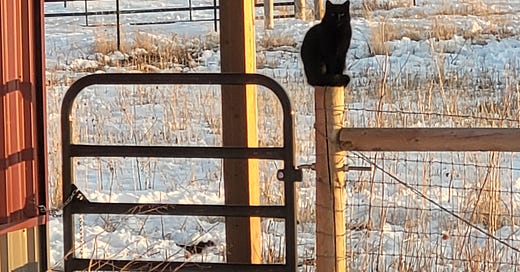Which Cat Is That
I cannot say. Although I recognize it as one of the Kattens, so-called, being the youngest generation of our Porch Kitties. They were formerly called Kittens, until they outgrew both the diminutive and their mother, Jaden, who is rather small. But whether this cat is Katten Major or Katten Minor, at this distance I cannot tell. A tom or a queen you ask, but I cannot answer. They are shy creatures, rather chary of human conversation, and our interviews to date have not trespassed upon that subject.
What Sort Of Cat
Is s/he a polecat? An intuitive guess, but no. A polecat, I am informed, is a weasel-like Eurasian mammal, famous for employing a particularly potent eau de cologne as a means of defense. The term is sometimes applied, albeit incorrectly, to a black and white striped North American animal, which my father called a sachet pussycat.
Perhaps a pole sitter then? More literally accurate, but still incorrect. Pole sitting was a fad in the 1920s, wherein humans would mount a small platform atop a flagpole and see how long they could stay aloft. The practice died out in the 1930s. There was a brief attempt to revive pole sitting in the early 1960s, at the county fair in Turnipsburg, Wisconsin. “We had this great idea to combine pole sitting with our annual beer drinking contest, in a sort of biathlon,” a local organizer explained. “In retrospect, perhaps we should have made pole sitting the first leg of the competition.”
Where Is That Cat
Is s/he in the pole position? Not exactly. In motorsports, the pole position is the car in front at the start of the race. The term derives from horse racing, where the horse that starts by the inside rail is in the pole position. Since I see no other cats present, a racing term seems inapt.
Is s/he on the fence? Well, yes, but no. On the fence suggests an inability or unwillingness to choose between two options in the face of controversy. I’ve always pictured such a person atop a picket fence, an uncomfortable position to be sure.
To me s/he looks more at equipoise, a situation in which one’s choices are perfectly balanced. One could jump down in the barnyard, or the garden. But what’s the rush?
Why Is S/he There
Why do cats insist on jumping up on things? A recently completed study sought to answer that question. After five years of intensive study supported by $3.2 million of NIH funding, the researchers reached a tentative conclusion. Cats jump up on things because they can.
I say s/he is up there to be in the catbird seat, an idiom that describes a position of advantage. The phrase originated in the American South and was used in print in 1942 in a humorous short story of that name written by James Thurber. However, in this context, it means an advantageous position in which one may observe the arrival of the meadowlarks, who nest on the ground, but also like to sit on fences when they can.





Very creative!